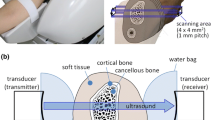Abstract:
The aim of this study was to evaluate the influence of immersion time and rotation of the heel around the leg axis on the reproducibility of measurements using an ultrasound bone imaging scanner (UBIS) with a temperature-controlled water bath. Measurements were obtained in 10 men, 11 premenopausal women and 10 postmenopausal women. The right foot of all subjects was scanned 12 times with an interval of 3 min between each scan. The first 10 measurements, performed to study the effect of immersion time, were taken without intermediate repositioning. Measurements 11 and 12 were also taken without removing the foot, but the calcaneus position was varied by an angle of ±2.5° with respect to the reference position used during the first 10 measurements. Prolonged immersion of the heel led to a decrease in the variations of quantitative ultrasound (QUS) parameters between successive measurements. Following rapid variations with immersion time, the QUS parameters reached a plateau. The effect of immersion time on measurement error remained significant until the first two or three scans for broadband ultrasound attenuation (BUA) and until the sixth or seventh scans for speed of sound (SOS). The variation in BUA was more pronounced (p<0.05) for the group of postmenopausal women (20.7% change in BUA between the first and tenth scans; p<0.005) than for the group of premenopausal women (6.8% change in BUA between the first and tenth scans; p<0.005). The variations in SOS were similar in the two groups (0.8% variation; p<0.005). The impact of immersion time was smaller for men than for women [2.5%, (p<0.01) and 0.4% (p<0.005) of the change between the first and tenth scans for BUA and SOS respectively]. On the whole, the measurement errors due to rotation of the heel were lower than those caused by immersion time. The variations were significant only in men and premenopausal women. Both immersion time and rotation of the heel may play a role in the precision of QUS and should be carefully standardized, particularly for longitudinal studies. In addition, following these results we have adopted a standardized protocol to derive the technique reproducibility in groups of premenopausal and postmenopausal women. The coefficients of variation were 1.1% for BUA and 0.1% for SOS in premenopausal women, and 1.4% for BUA and 0.13% for SOS in postmenopausal women.
Similar content being viewed by others
Author information
Authors and Affiliations
Additional information
Received: 17 February 1998 / Accepted: 1 September 1998
Rights and permissions
About this article
Cite this article
Chappard, C., Berger, G., Roux, C. et al. Ultrasound Measurement on the Calcaneus: Influence of Immersion Time and Rotation of the Foot . Osteoporos Int 9, 318–326 (1999). https://doi.org/10.1007/s001980050154
Issue Date:
DOI: https://doi.org/10.1007/s001980050154




